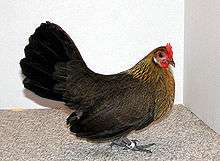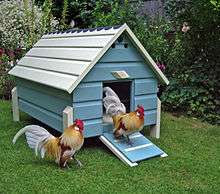Dutch Bantam
The Dutch Bantam (Dutch: Hollandse Kriel) is a breed of bantam chicken originating in the Netherlands.[6][7] It is a true bantam, a naturally small bird with no related large fowl from which it was miniaturized.[8]:136 It is kept mainly for exhibition, and has been bred in many color varieties; it is a good layer of small eggs.[9]:45
 Dutch Bantam pullet | |
| Conservation status | FAO (2007): endangered[1]:84 |
|---|---|
| Other names | Dutch: Hollandse Kriel |
| Country of origin | the Netherlands |
| Standard | |
| Traits | |
| Weight | |
| Skin color | white |
| Egg color | white[2] |
| Comb type | single with 5 points |
| Classification | |
| ABA | single comb clean legged[3] |
| EE | yes[4] |
| PCGB | true bantam[5] |
| |
History
Diminutive chickens of similar coloration to today's Dutch Bantams have been seen in the Netherlands for hundreds of years, but the exact origin of the breed is unclear. It is likely that the ancestors of the Dutch Bantam were Southeast Asian bantams brought back by sailors from the Dutch East Indies.[10]:119 Historically, it is supposed that these tiny chickens were selectively bred because only small eggs could be kept by peasant farmers, while larger ones were required to be sent to the kitchens of the landed gentry.[10]:119 The first written reference to the Dutch Bantam as a distinct breed is in the Hand- en standaardboek of R.T. Maitland, director of the Royal Zoological Botanical Gardens of The Hague, published in 1882; he referred to them as patrijskrielen, "partridge bantams".[11] The Nederlandse Hoender Club, the Dutch national poultry club, recognized the breed in 1906.[8]:136[12] A breeders' association, the Hollandse Krielenfokkers Club, was formed in 1946.[13]
The Dutch Bantam was first exported to the United States in the 1950s.[10]:120 It was included in the Standard of Perfection of the American Poultry Association in 1992 in two colors; four others were later added.[3] It reached the United Kingdom towards the end of the 1960s; the British Dutch Bantam Club was formed in 1982, and thirteen colors are standardized.[7]:105 It is also reared in Germany[2] and in South Africa.[9]:45
Characteristics

Dutch Bantams are among the smallest breeds of true bantam. Cock birds should weigh no more than 550 grams, and hens 450 grams. Due to their light weight and relatively large wings, Dutch Bantams fly rather well. The original type of plumage for Dutch Bantams was a partridge pattern. Twenty-nine colour varieties are recognised by the Dutch association.[13] All varieties should have a comb with 5 points, white earlobes, slate blue legs, apart from certain varieties and white skin.
The breed is friendly in temperament, but somewhat flighty. Their small size and comb type makes them not especially cold hardy. Dutch Bantam hens make good mothers and will easily go broody. Uniquely for bantams, and especially ones popular in showing, Dutch Bantams lay well; they can produce 160 cream or white eggs in a year, though the size of the egg is much smaller than commercial layers. Due to their friendly character and egg laying ability, the breed is well suited to hobbyists and backyard keepers needing a bantam-sized bird.[9]:45
References
| Wikimedia Commons has media related to Dutch Bantam. |
- Barbara Rischkowsky, D. Pilling (eds.) (2007). List of breeds documented in the Global Databank for Animal Genetic Resources, annex to The State of the World's Animal Genetic Resources for Food and Agriculture. Rome: Food and Agriculture Organization of the United Nations. ISBN 9789251057629. Accessed January 2017.
- Rassetafeln: Zwerghühner (in German). Bund Deutscher Rassegeflügelzüchter. Accessed October 2018.
- APA Recognized Breeds and Varieties: As of January 1, 2012. American Poultry Association. Archived 4 November 2017.
- Liste des races et variétés homologuée dans les pays EE (28.04.2013). Entente Européenne d’Aviculture et de Cuniculture. Archived 16 June 2013.
- Breed Classification. Poultry Club of Great Britain. Archived 12 June 2018.
- Chickens: True Bantam. Poultry Club of Great Britain. Archived 27 October 2018.
- Victoria Roberts (2008). British poultry standards: complete specifications and judging points of all standardized breeds and varieties of poultry as compiled by the specialist breed clubs and recognised by the Poultry Club of Great Britain. Oxford: Blackwell. ISBN 9781405156424.
- Chris Graham (2006). Choosing and Keeping Chickens. London: Octopus Publishing. ISBN 9780793806010.
- Jeremy Hobson, Celia Lewis (2009). Choosing & Raising Chickens: The complete guide to breeds and welfare. London: David & Charles Publishing.
- Carol Ekarius (2007). Storey's Illustrated Guide to Poultry Breeds. North Adams, Massachusetts: Storey Publishing. ISBN 9781580176675.
- Elly Vogelaar (February 2007). Chicken Run. Aviculture Europe 3 (1): section 5.
- Hollandse Kriel (in Dutch). Hollandse Krielenfokkers Club. Accessed May 2018.
- Home (in Dutch). Hollandse Krielenfokkers Club. Accessed May 2018.